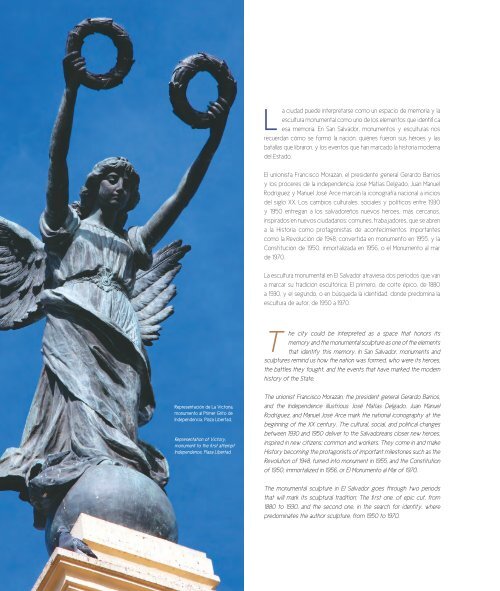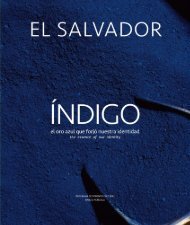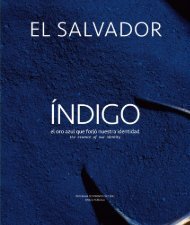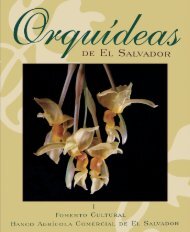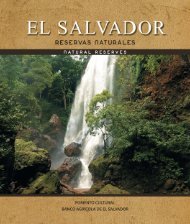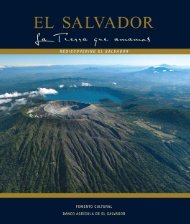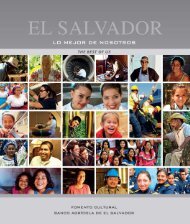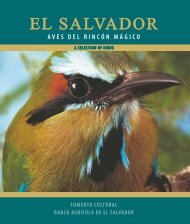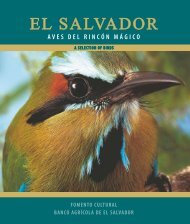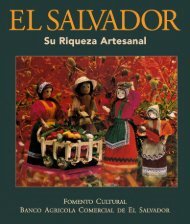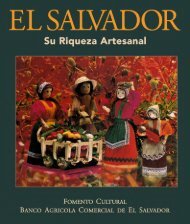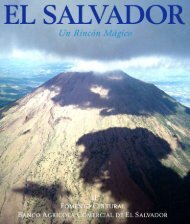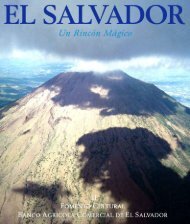Monumentos y Esculturas del Rincón Mágico
Create successful ePaper yourself
Turn your PDF publications into a flip-book with our unique Google optimized e-Paper software.
L<br />
a ciudad puede interpretarse como un espacio de memoria y la<br />
escultura monumental como uno de los elementos que identifica<br />
esa memoria. En San Salvador, monumentos y esculturas nos<br />
recuerdan cómo se formó la nación, quiénes fueron sus héroes y las<br />
batallas que libraron, y los eventos que han marcado la historia moderna<br />
<strong>del</strong> Estado.<br />
El unionista Francisco Morazán, el presidente general Gerardo Barrios<br />
y los próceres de la independencia José Matías Delgado, Juan Manuel<br />
Rodríguez y Manuel José Arce marcan la iconografía nacional a inicios<br />
<strong>del</strong> siglo XX. Los cambios culturales, sociales y políticos entre 1930<br />
y 1950 entregan a los salvadoreños nuevos héroes, más cercanos,<br />
inspirados en nuevos ciudadanos: comunes, trabajadores, que se abren<br />
a la Historia como protagonistas de acontecimientos importantes<br />
como la Revolución de 1948, convertida en monumento en 1955, y la<br />
Constitución de 1950, inmortalizada en 1956, o el Monumento al mar<br />
de 1970.<br />
La escultura monumental en El Salvador atraviesa dos periodos que van<br />
a marcar su tradición escultórica: El primero, de corte épico, de 1880<br />
a 1930, y el segundo, o en búsqueda la identidad, donde predomina la<br />
escultura de autor, de 1950 a 1970.<br />
T<br />
he city could be interpreted as a space that honors its<br />
memory and the monumental sculpture as one of the elements<br />
that identify this memory. In San Salvador, monuments and<br />
sculptures remind us how the nation was formed, who were its heroes,<br />
the battles they fought, and the events that have marked the modern<br />
history of the State.<br />
Representación de La Victoria,<br />
monumento al Primer Grito de<br />
Independencia, Plaza Libertad.<br />
Representation of Victory,<br />
monument to the first attempt<br />
Independence, Plaza Libertad.<br />
The unionist Francisco Morazán, the president general Gerardo Barrios,<br />
and the Independence illustrious José Matías Delgado, Juan Manuel<br />
Rodríguez, and Manuel José Arce mark the national iconography at the<br />
beginning of the XX century. The cultural, social, and political changes<br />
between 1930 and 1950 <strong>del</strong>iver to the Salvadoreans closer new heroes,<br />
inspired in new citizens; common and workers. They come in and make<br />
History becoming the protagonists of important milestones such as the<br />
Revolution of 1948, turned into monument in 1955, and the Constitution<br />
of 1950, immortalized in 1956, or El Monumento al Mar of 1970.<br />
The monumental sculpture in El Salvador goes through two periods<br />
that will mark its sculptural tradition: The first one, of epic cut, from<br />
1880 to 1930, and the second one, in the search for identity, where<br />
predominates the author sculpture, from 1950 to 1970.<br />
78


